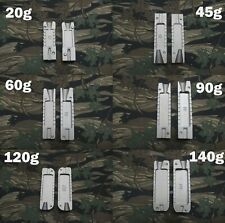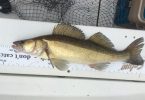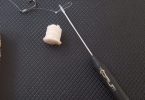{This is an article that Chris wrote some time back for another website. Although the subject is barbel fishing, Chris is keen to point out that the same principles apply to trotting for chub – Ed}
Picture the scene
……it’s high summer, the sun is high in the cloudless sky, the day is hot and sultry. You’re by a river – it is low and gin clear, nothing stirs until a Kingfisher announces its approach with a shrill whistle as it flashes by like a fighter plane trying to keep below the RADAR. Conditions are not conducive for good sport and the barbel angler is having a siesta – waiting for dusk and a better chance of a bite. These conditions aren’t entirely hopeless however. Barbel can be caught quite easily – and using a method which gives immeasurable enjoyment. And if it means having to wade up to your thighs in cooling water – so much the better.
Of course I’m talking about getting the float rod out, strapping on a centre pin and Trotting for Barbel. Now I’m not knocking the bait and wait approach – I’m just as likely as the next barbel angler to sit poised over a quiver tip as the light fades. And I’m more likely to catch bigger fish this way. BUT I have to admit catching them on the float is way more fun – and whilst they won’t be as big as the ones I might catch at dusk – I’m likely to get more. This article is about sharing my approach and experiences in catching barbel float fishing – honed over 30 years of fishing the Kennet.
Swim Selection
Early in the season barbel are usually found close to where they have spawned. This often means they are in fast, shallower water. I look for a long fast glide – preferably channels between weed. My ideal (and all my most productive swims now I come to think of it) end in some kind of feature – an overhanging tree, a weed raft, a bridge – somewhere where there may be cover adjacent to the glide. Barbel like a roof over their head – and these features are particularly important if your river has suffered a loss of Ranunculus like the Kennet. My all time favourite trotting swim on the Kennet has trees at the beginning and end of the swim. The run off from weirs are another place to investigate – in fact my first ever barbel – a 2.3/4 lb fish was caught float fishing bread (I was after chub!) from just such a swim.
Tackle & Set Up
One of the best bits of advice I ever took was from Alan Tomkins – who recommended (and still does) the Harrison 15′ Gti float rod.
I’ve had mine for a decade now and its seen a lot of action in that time. The rod is perfect for the job as it has enough power to cope with the heavier fight that even a smallish barbel will give in a strong current (providing you get the hollow, and not the spliced, tip). Reel of course is a centre-pin. When I was 7, I first started fishing with a centre-pin – but like most of my contemporaries, pocket money was quickly saved in order to buy that coveted ‘Black Prince’ fixed spool! And my 2.3/4 inch boys centre-pin reel was consigned to the shed. My conversion back to centre-pins happened over 15 years ago when I started to do a lot more winter fishing and quickly realised that for trotting a ‘pin is simply the best tool for the job. Since then the number of pins I’ve acquired as grown and I have to admit I’ve become something of a ‘Pin Tart’! I use two reels the most – a Chris Lythe for barbel and the more lightweight, and simply lovely to use, Witcher Aerial for my Grayling fishing. However you don’t have to spend your inheritance – for a first pin the Okumas have had excellent reviews or of course there’s always the excellent Anglersnet pin.
For this article I shall be using my Purist. It is loaded with about 40-50m of 8 lb Fireline Crystal. Fireline has a number of advantages for trotting. It is highly buoyant and thus easy to mend without disrupting the passage of the float. (Mending means taking up any excess line in order to keep in contact with the terminal tackle). The lack of stretch means it’s quick into the strike – particularly important if your striking at distance (remember those swims which end in a feature – the barbel may well be ambushing your bait from there). The only potential disadvantage with Fireline is that it’s not so easy to Wallis cast with. I’m not going to attempt to describe this technique – though some of you may be interested in the video clip that my mate Glenn Smith made for Anglersnet which can be viewed here…
At the business end a length of mono – I usually use 6 lb – so that you have some ‘give’ in the set up – or you can do what a friend of mine has tried and use a piece of pole elastic. For floats I use loafers – they carry quite a bit of shot – and I prefer to err on the side of too much shot rather than too little. I will usually use a 2.5 ssg float as a minimum – sometimes going up to 4 or 5 ssg if conditions dictate. As for shotting patterns I think this is a matter for personal preference. Some prefer putting all the shot together about 12-18 inches from the hook. I prefer to space them up the line ‘shirt button’ style as I believe this gives a more natural presentation particularly when you ‘hold back’ and allow the bait to flutter up in the current. (However, see ‘Stret-pegging’ below). A small swivel somewhere in the rig – mine’s between line and hook length is an essential requirement if you want to minimise line twist (Try retrieving double maggot from 40m in a fast current without it!)
Hooks – I usually go for 14’s – something like a Drennan Super Spade is ideal. 14 is something of a compromise – small enough to allow me to pick up silver fish – large enough to cope with the size of barbel I’m likely to encounter (3-5 lb’ers) If I think there’s a chance of something bigger I’ll scale up to a 12 – though this seems to dramatically cut down on the number of dace I get.
Tactics
Trotting is fairly straight forward. The only really important fact to remember is that the current is faster at the surface than at the bottom. Set the float slightly over depth and ensure that the bait precedes the float down the swim. Do this by either checking the reel with your thumb – or if your using a reel like the Purist set the micro-drag so that the float only just pulls off line. Try different ‘lines’ through the swim – this may mean checking the float so it swings around in the current and then letting it continue its journey on a slightly different route. Occasionally stop the reel altogether and let the bait flutter in the current – bites when you do this will often be savage – you won’t need to strike! Do this especially at the end of the swim. I’ll often let the bait flutter for quite some time – 30secs or so before retrieving.
What is a must, is in introducing bait into the swim. Little and often is a maxim which you should stick to – in this case little and VERY often. I like to keep an almost constant stream of maggots trickling through the swim. Ideally you should get the bait dropper out for the first hour and not fish at all. To be honest though I’m usually too impatient as I will often only have 3 or 4 hours at the river. A bait smock then is a must. My left hand constantly introducing half a dozen maggots every 20 seconds while my right hand holds the rod and controls the reel. Even when I’m playing a fish I’ll try and keep introducing some bait.
Don’t expect action instantly. I’ll often content myself catching dace – perhaps from a slightly different line – while all the while introducing a trickle of maggots. When they (the barbel) come on the feed – and this may take up to 2 hours – things can suddenly get manic and you may get a number of fish very quickly. 6 to a dozen fish in an hour is a possibility!
Stret-Pegging
Something of a lost art – but a method which can be deadly – particularly if sport has been a little slow. Basically the rig is the same as before though now you fish a long way over depth as well as over-shotting the float. All the shot is bulked about 12 inches from the hook. Ca
st out to the head of the swim and ensure that you set the depth so that the float is on the surface. Your bait will be nailed to the bottom. The technique is about inching your bait through the swim. Do this by lifting the float so that the shot dislodges on the bottom and trundles a few inches downstream. Drop your rod tip to hold it in this new position. Wait a couple of minutes and repeat until the entire swim has been covered. The point where you move the bait is when you should be ready for a bite – which for some reason is always violent! I can picture what might be happening beneath the surface – perhaps the fish are inspecting the bait when it suddenly starts to leave their immediate vicinity – thus prompting them to make up there minds to have it! Pure supposition I know – but there’s never anything subtle with the bites you get when Stret-pegging.
For Stret-pegging to be really effective your rod tip needs to be in-line with the float. Casting across the current won’t work very well as it will mean you pull the bait out of line each time you lift ‘to trundle’. Thus it works best on near bank swims – or it means having to wade. (And it’s another reason for having a bit more reach that a 15′ rod gives you).

Stret-pegging from the compound at the top weir on the Royalty with the levels a bit on the high side
A Recent Trip
Let me describe a recent trip which graphically illustrates some of what I’ve been saying. Summer 2005 saw the Kennet in drought condition – and this particular day in late June was much as I described at the beginning of my piece. Hot and sunny. I had the day off to go my youngest’s Sports Day so had little over 3 hours of fishing time. My plan was to fish three swims in turn – each just downstream of the other. It looked like this plan may be scuppered as on arrival – rather than have the fishery to myself as I expected, it being mid-week – there was an angler in the last (and downstream) of these three swims. He was ledgering meat and had managed a 4 lb barbel a couple of hours earlier.
I bade him good luck and started in the upstream swim. This is best attacked by wading out a couple of yards so that you can get a clean run under the tree at the bottom of the swim. The maggots start to get introduced – and I’m quickly into some dace. After 1/2 hour of this I concentrate my efforts on the tree at the tail of the swim and get 3 chub in four casts. The biggest is a 4 lb’er the other two half this. I fish on for another 20 mins but bites have dried up.
I switch to the second swim with very similar results – nothing for 30 mins then 5 chub – all around 2 lb in the next half an hour.
It’s now 12noon – I need to be on the road by 1pm and to my delight the third swim has just been vacated, the angler not having added to his earlier barbel. I’m nearly out of maggot – having got through 2 pints in the previous 2 and a bit hours but I’m confident this swim will have been receiving a steady stream of bait – and so it proved.
There’s a famous short story by G.E.M. Skues about a Mr Theodore Castwell – who is condemned for eternity to catch the same 2.1/2 lb trout from the same lie with the same fly. By 12.45 on this particular summers day I was beginning to appreciate Mr Castwell’s predicament. 6 Trots through the swim produced 6 fish with the float burying each time at EXACTLY the same spot (a slight crease where the current was being deflected by a bank-side bush). The only difference was in the size of the fish I landed – all barbel of course, the biggest 5.1/4 lb with the majority some 1/2 lb lighter. I am able, in this swim, to get downstream of the fish quite quickly and get the fish out of the main flow so as not to disturb the shoal. On my 7th trot I hooked a trout. A very acrobatic and splashy fish which killed the swim – I was almost thankful – my wrist was killing me!
I have no doubt that the continuous trickle of bait had turned these fish on the feed – right beneath the ‘unknowing’ nose of another angler!!
A Barbel for Glenn
I’ve known Glenn for a few years now – having met through Anglersnet (though he‘s an infrequent visitor these days). I’ve taken Glenn fishing a few times and have had the pleasure of introducing him to his first Grayling, Pike and Barbel. The barbel was a couple of summers ago. Glenn is a bit of a centre-pin addict and his request of me wasn’t just that he wanted to catch a barbel – but it had to be float caught – with a pin.
Our first attempt failed – I put Glenn in my favoured Two Trees swim and fished a lesser spot upstream. Embarrassingly I soon had a couple of barbel, some chub and even a 9 lb+ pike on trotted maggot while Glenn struggled. I stood with him to see what he was doing and gave him a couple of pointers as to the best line – this at least yielded a nice chub. The day was saved – for Glenn – by catching his first Pike – after I’d reported a fish that kept slashing at the dace I was catching.
We were back in the September – again Glenn had Two Trees though this time I fished downstream of him. Yet again I was first into a barbel and immediately insisted Glenn took over as I was sure they’d be more. Thankfully I was right – and the result is below.

Probably the smallest barbel in the swim….but it certainly made Glenn happy!




















